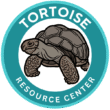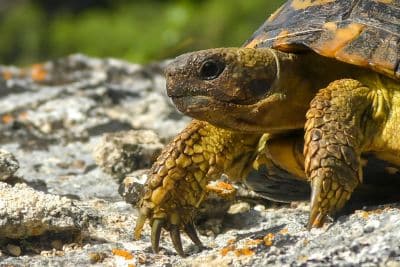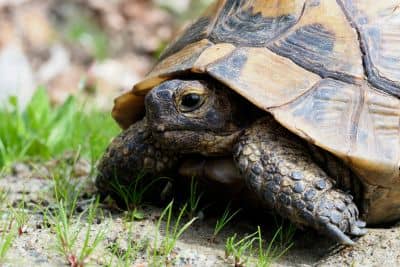Celebrated for their small size, Egyptian tortoises (Testudo kleinmanni) are some of the most beloved chelonians in the world.
Unfortunately, these tortoises are in great peril. The IUCN Redlist of Threatened Species categorizes them as “critically endangered,” and according to US Fish and Wildlife Services estimates, less than 11,000 individuals are still alive in the wild.
Nevertheless, they can make excellent pets for committed owners when and where they’re legally available.
Enclosures
As with all reptiles, captive Egyptian tortoises require a safe and suitable enclosure to remain healthy.
It’s almost always better to house tortoises outside, where they’ll be exposed to natural sunlight.
However, this is only possible if you live in a climate similar to the Mediterranean environment these tortoises experience in the wild. And even in these cases, there will often be times when the outdoor temperatures or weather are unsuitable for your pet.
So, it is often best to set up an indoor and an outdoor enclosure, that way you can move your tortoise outdoors during good weather and move your pet back indoors when the temperatures drop or during periods of inclement weather.
Outdoor enclosures can be made from various materials, including cement blocks, corrugated metal panels, or wood. But in all cases, the walls of the enclosure should extend at least 12 inches below the surface to prevent the tortoises from digging beneath the walls.
In addition, outdoor enclosures also require a wire top to protect the tortoises from predators. It’s also essential to provide a large, shaded area so that the inhabitants can escape the sun if need be.
Indoor enclosures can take various forms, but commercially built plastic reptile cages or purpose-built “turtle tubs” are the two best options. Glass aquaria do not provide enough ventilation for these tortoises, and the glass may lead to stress.
Whether you house your tortoises indoors or outdoors or shift them back and forth between indoor and outdoor habitats, you must provide enough space. Egyptian tortoises are surprisingly active, so they still need spacious accommodations despite their small size.
A single adult will require an enclosure measuring at least 36” x 18”, but 48” x 24” enclosures are preferable. Enclosure height isn’t essential – anything exceeding 12” will suffice.
When I house multiple tortoises together, I always ensure that I can provide at least 4.5 square feet of space per individual.
Once the housing structure is complete, you’ll need to line it with a ground cover – also known as substrate. A few of the most common choices include tortoise-safe barks and mulches, custom blended sand-and-soil mixtures, crushed coral, and commercial tortoise substrates.
These options can work as long as the materials chosen are non-abrasive, non-toxic, and unlikely to cause intestinal obstructions if swallowed. Utilizing a substrate that permits burrowing is always preferable, as this is a natural behavior of Egyptian tortoises.
When the substrate is in place you will need to provide at least one – and preferably several – hiding spots. The hide should be dark and barely large enough to accommodate the tortoise. If you house multiple tortoises together, provide one for each individual.
It is also essential to provide additional objects of interest, such as non-toxic plants, rocks and logs that’ll serve as visual barriers and provide opportunities for exploration and well-being. It is well worth rearranging the cage furniture pieces periodically to keep your tortoise mentally stimulated.
Light, Heat and Humidity
With a proper habitat established, you can focus on the environmental conditions your tortoise needs to thrive.
Egyptian tortoises are required in an indoor enclosure to mimic the Mediterranean climate, so you’ll need to use heat lamps or radiant heat panels. Cluster the heating devices at one end of the enclosure to create a thermal gradient – a range of temperatures that fall with increasing distance from the heating devices.
I prefer a multi-purpose heat lamp that provides both heat and UV light and a personal favorite is the PewinGo Reptile Heat Lamp.
Be sure to use thermometers (and a thermostat if you use radiant heat panels) to maintain proper temperatures.
Directly under the heat lamp or radiant heat panel, temperatures should be between 90°F and 100°F. Temperatures at the opposite end of the habitat should be between 70°F and 80°F. You may need to experiment with different bulb wattage, heat panel settings, or distances from the enclosure to achieve the proper temperatures.
Be sure to turn your tortoise’s heating devices down or off at night to allow the enclosure temperatures to fall between about 65°F and 70°F.
Egyptian tortoises can dehydrate quickly, especially when young. Typically, the best approach is to mist your tortoise enclosure each morning with room-temperature water. Spray the enclosure walls and substrate thoroughly (don’t directly spray the tortoises), but ensure that it dries out by midday – you do not want the enclosure to remain damp overnight.
Many keepers also employ a regular soaking regimen, in which the tortoises (especially young individuals) are given a short bath in warm, shallow water each day.
Finally, be sure that a clean, shallow bowl of water is always available for drinking.
Like most other tortoises, Egyptians require high-quality, “full spectrum” lighting. This means you’ll need to use lights that produce visible light and light in the UVA and UVB portions of the spectrum.
You can do this with fluorescent tubes or mercury vapor bulbs designed for reptile use. Fluorescent tubes are more affordable, but they do not produce heat. You’ll need to use them with heat lamps or radiant heat panels. By contrast, mercury vapor bulbs are more expensive but will satisfy your tortoise’s lighting and heating needs.
Be sure to place the bulbs or tubes within 12 to 18 inches of the enclosure’s substrate and replace them frequently – no more than once every six months.
Food
As with all captive reptiles, keepers must provide a suitable diet for their pets. This not only includes providing the right kinds of foods but also providing the food on an appropriate schedule.
Egyptian tortoises are likely omnivores in the wild, who occasionally consume invertebrates or carrion, but keepers generally provide them with an entirely herbivorous diet. To avoid deficiencies, offering a wide variety of plants and vegetables is wisest, but the bulk of their diet should be leafy greens mixed with some grasses for fiber.
Young Egyptian tortoises should be fed daily food as much as they consume within 30 minutes. Adults can be fed six days per week. Do not leave uneaten food in the enclosure.
Safe Foods
Some of the best foods to feed an Egyptian tortoise include:
- Mustard and turnip greens
- Dandelion greens
- Escarole
- Chicory
- Grape leaves
- Leaf lettuce
- Hibiscus flowers
- Non-toxic grasses
- Commercial pellets
- Shredded carrots
- Small pieces of squash
Toxic Foods
Some foods you should avoid feeding your Egyptian tortoise include:
- High-oxalate foods that can inhibit calcium absorption, including spinach, kale, and chard
- Grass or hay that may have been exposed to herbicides, pesticides, or insecticides
- Toxic plants, such as nightshade or rhubarb, which may sicken your pet
- Animal-based foods, such as pinky mice or crickets, are too rich for the tortoises
Supplements and Vitamins
Most experienced tortoise keepers provide supplemental calcium to Egyptian tortoises once per week.
If you usually keep your tortoises indoors, selecting a calcium supplement containing Vitamin D3 is wise. Administer the supplemental calcium by sprinkling it on your tortoise’s food.
You can also provide supplemental calcium in the form of cuttlebone. I find that this allows the tortoises to consume the calcium as needed, rather than the keeper determining the amount of calcium to provide.
Additionally, many keepers provide a vitamin supplement on a once-per-week schedule to help prevent deficiencies.
Are You Starving Your Tortoise?
Save 10% on premium tortoise food and supplements from Tortoise Resource Center on Amazon now using code BUYNOWGET10
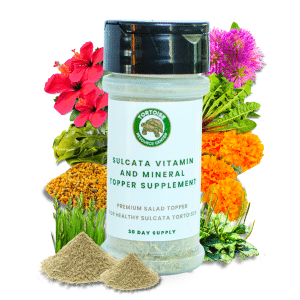
Sulcata Vitamin & Mineral Topper Supplement
30-Day Supply | 2 oz (56 g)
$24.99
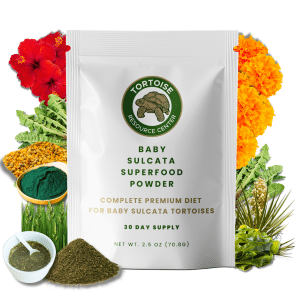
Baby Sulcata Tortoise Superfood Powder
30-Day Supply | 2.5 oz (70.8 g) Bag
$24.99
Health and Wellness
When provided with proper care, captive-bred Egyptian tortoises generally remain healthy. However, keepers should watch for a few health concerns and treat them promptly.
A few of the most common health problems Egyptian tortoises can suffer from include:
- Dehydration: Tortoises – particularly young individuals – may succumb to dehydration without sufficient drinking and bathing water. Signs of dehydration include cracked scales, sunken eyes, and poor appetite. If you suspect your tortoise is dehydrated, begin providing more baths immediately. See veterinary care if your tortoise’s health and behavior fail to improve within 48 hours.
- Respiratory infections: Tortoises who are lethargic, exhibit nasal discharge, “blow bubbles,” or engage in open-mouthed breathing may suffer from respiratory diseases. Because these can be deadly, increasing enclosure temperatures slightly (no more than 5 degrees) and seeking immediate veterinary assistance is essential.
- Skin or scale rot: Wounds or lesions on the skin or shell can be a sign of infections or necrosis, which can quickly worsen. If you note either of these problems, immediately clean your tortoise’s enclosure and contact your vet.
- “Pyramiding”: Tortoises not provided with sufficient water and suitable humidity may develop improperly, leading to a pyramid-like appearance. This can be avoided by providing proper humidity levels while the tortoises are young and implementing a regular bathing regimen.
General Tortoise Husbandry
Proper maintenance procedures can help keep your tortoise healthy and ensure he or she thrives. Among other things, this means you should:
- Clean your tortoise’s enclosure daily to remove feces, bits of shed skin, and uneaten food.
- Wash your tortoise’s food and water dishes daily with soap and warm water.
- Check the temperatures in your tortoise’s enclosure at least twice per week (and every day while first setting up the habitat).
- Visually inspect your tortoise for injuries or symptoms of illness every day.
- Track your tortoise’s weight to ensure he or she is growing correctly while young and not losing weight once he or she matures.
- Visit your veterinarian every 6 to 12 months for a checkup.
Socialization and Handling
Captive-bred Egyptian tortoises rarely require extensive socialization, as they’re naturally docile. They can be gently handled periodically, but avoiding them too frequently is essential, as this can lead to stress.
Generally, you’ll want to handle your tortoise no more than once or twice per week. When doing so, support the tortoise’s weight securely and avoid making rapid moves near your pet’s face, which may frighten the tortoise.
A better way to interact with your tortoise is to leave him or her on the ground or substrate and feed him by hand. Over time, some Egyptian tortoises will learn to associate their keeper with food.
Behavioral Issues
Egyptian tortoises rarely exhibit behavioral problems, although some individuals may be shy and remain hidden more often than their keepers would like. There’s not a great deal you can do to change this – it’s a natural behavioral pattern, as these tortoises hide for a large portion of their lives in the wild.
However, you can encourage your tortoise to leave his or her hiding space more frequently by making the enclosure feel as safe as possible. That means avoiding placing the enclosure in a high-traffic area and keeping other pets (such as dogs and cats) away from the habitat.
With time and patience, you should be able to help your tortoise feel safe and associate you with positive stimuli (i.e. food).
Breeding
Egyptian tortoises are not bred with the frequency of some other species, but it is a worthwhile pursuit, given the species’ declining numbers in the wild.

Just be sure that breeding these tortoises is legal in your area and that you can find homes for the resulting offspring. This is important as interstate commerce of these tortoises is illegal in the U.S.
Many keepers find it helpful to induce breeding in Egyptian tortoises to allow males to engage in combat (always supervise such interactions and separate the tortoises before either suffers an injury).
Once the males engage in combat, they can be introduced to mature females. With luck, breeding will commence. Small eggs will be deposited over the next several months and can be incubated at around 86 degrees Fahrenheit. Approximately 80 to 120 days later, the young will begin hatching.
The young are best kept in a “nursery” for the first week or so of their lives. You want the nursery to be warm and have high humidity, but it is essential that it is not kept excessively wet.
Citations
- Journal of Animal Physiology Animal Nutrition – Humidity and Influence on Shell Pyramiding
- IUCN Redlist of Threatened Species – Testudo kleinmanni
- Merck Veterinary Manual – Upper respiratory tract disease, tortoises
- US Fish and Wildlife — Threatened Species: Egyptian Tortoise
